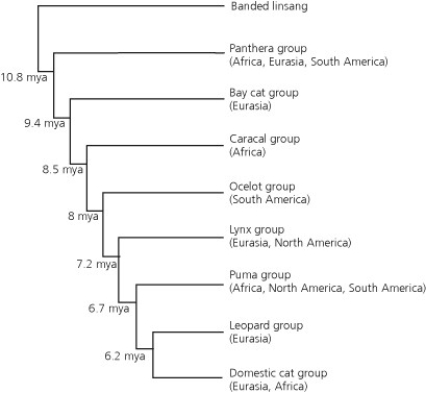Multiple Choice
The family Felidae (cats) is distributed across Africa, Eurasia, North America, and South America and is hypothesized to have eight major lineages (Panthera, bay cat, caracal, ocelot, lynx, puma, leopard, and domestic cat groups) as shown in this phylogenetic tree, constructed from DNA sequences. Scientists used a molecular clock and fossil evidence to date the divergence of each group. The dates of divergence are provided in the accompanying figure.

-The cheetah, which is currently found in Africa, is part of the puma group. Which of the following predictions is most consistent with the evolutionary hypotheses represented in the phylogenetic tree?
A) The common ancestor of all the species in the puma group dispersed from Africa more than 10 million years ago.
B) A land bridge between North America and Eurasia formed as a result of lowered sea levels between 4 and 7 million years ago.
C) The cheetahs evolved from the lynxes between 7 and 9 million years ago while Laurasia was still connected to Gondwana.
D) All the cats that are currently found in Africa evolved from a common ancestor in Eurasia about 9 million years ago.
Correct Answer:

Verified
Correct Answer:
Verified
Q29: The three-domain system<br>A) no longer recognizes eukaryotes
Q30: Biologists are studying two species whose DNA
Q31: The family Felidae (cats) is distributed across
Q32: In mammals, the presence of four limbs
Q33: The 14C:12C ratio can be used to
Q35: A systematist includes a lizard in a
Q36: It is estimated that the modern continents
Q37: One of the strongest lines of evidence
Q38: _ makes it possible to trace phylogenies
Q39: The family Felidae (cats) is distributed across